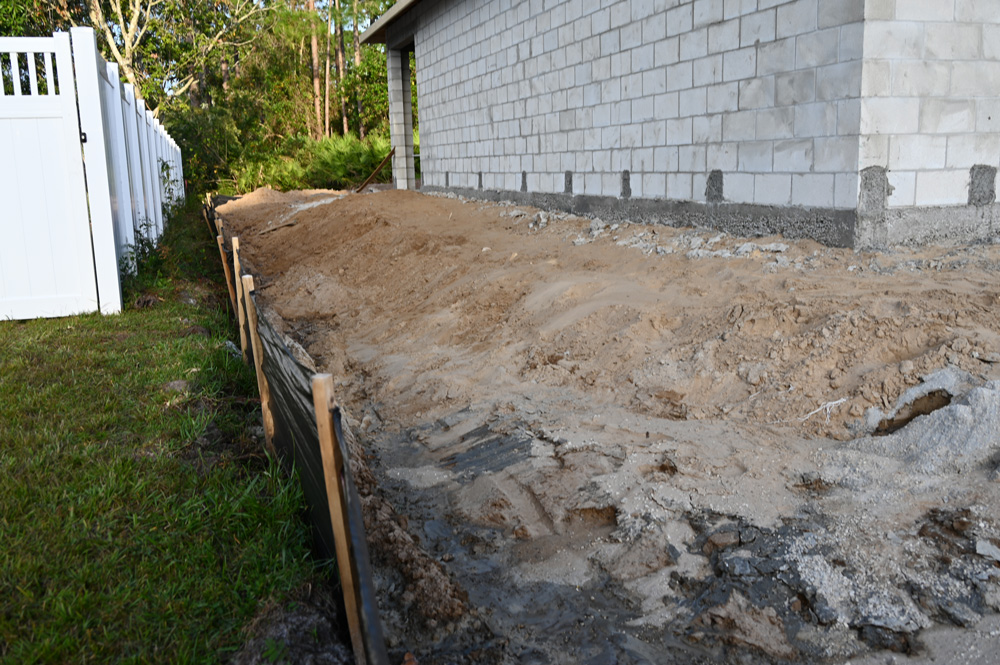
For months, residents of Palm Coast’s older sections have been complaining about new homes rising next to them at sharply higher elevations, and seemingly causing flooding on their own lots.
The complaints upended city priorities. The city launched a task force to analyze the problem and seek solutions, at least to the extent that the city could provide them. That included a rewrite of the city’s technical manual for builders, which now specifically addresses base building heights, imposing limits, and a pledge to create a citizens’ advisory board focused on that one issue.
On Tuesday, however, Flagler County Emergency Management Director Jonathan Lord told the city council that, in a time of climate change and more pronounced flooding risks, those higher elevations are the way of the future.
“Property elevation are super important for hardening the community moving forward,” Lord said. “They are needed for community resiliency not just for flooding, but for other things too. Building codes not only cover flooding, they cover wind resistance, fire resistance and all that. In the past, the older codes did not adequately address what we’re seeing today with flooding. They weren’t wrong. That was just what we knew at the time.”
Today, he said, higher elevations have become essential to limiting flooding impacts. In other words, all those new homes getting built at higher elevations are doing it right. That leaves surrounding homes that were built to different codes, and that have literally settled, or sunk, down over the decades, contending with the consequences, as water on those lots has nowhere to go.
“The same thing on older homes,” Lord said. “If they have to be rebuilt or have damage in excess of 50 percent, they have to be rebuilt to the newer codes, which includes higher elevations.”
Lord told the council that “we’re definitely in a climate phase where the last decade or even five years, we’re seeing significantly more rain falling in Palm Coast, particularly than we did 25 years ago.” Winters’ dry seasons have not happened, he said, which is good news for keeping a damper on fire season. But it’s meant more rain. And there was this other surprise most residents may not have known about: “Sea level rise not only increases the mean water level on the Atlantic Ocean, it increases the mean water level, the average water level, on the Intracoastal,” Lord said. “And the Intracoastal is where a lot of the water in Palm Coast ultimately drains through once it makes its way through the storm water system. So as sea level rises that does have impacts on your stormwater infrastructure.”
The land Palm Coast was built on, he reminded the audience, was partly swamp and poorly drained wetland. ITT drained it so Palm Coast could be built. The city’s stormwater system has done the job since: the city is part of the National Flood Insurance Program, with Palm Coast as a so-called Class 4 community, “which equates to a 30 percent discount,” he said. “Not many communities in the country qualify for that discount.” Grants are also available to homeowners looking to “harden” their home, as long as they have flood insurance.
Council member Ed Danko questioned Lord on sea level rise and increased rainfalls. “Where are we getting this from?” He asked Lord. A combination of National Weather Service and other data, Lord told him.
“I mean, if you say sea level rise, it sounds like the sea is rising. Are we talking this much, or this much?” Danko asked.
“It’s inches,” Lord said. He didn’t have the exact numbers. But sea level rise is not a theory. According to Florida State’s Florida Climate Center, “Sea levels across Florida are as much as 8 inches higher than they were in 1950, and the rate of sea level rise is accelerating. For instance, sea levels around Virginia Key have risen by 8 inches since 1950, but they have been rising by 1 inch every 3 years over the past 10 years, based on tide gauge data. This acceleration in sea level rise is projected to continue.”
The over-exploitation of ground water is also a major culprit.
Lord was addressing the council in the context of its latest update during a Tuesday workshop on the flooding issue on so-called infill lots–those 48,476 mostly quarter-acre lots ITT platted as it designed Palm Coast. About 9,000 of those lots remain unbuilt. But the plan has always been for every infill lot being built on.
The city has registered and is investigating 174 cases of flooding complaints by residents. Typically, city staff visits and surveys the property where the complaint originates, analyzing what the source of the flooding may be. Of those complaints, 73 percent have originated at homes built before 2005 (before the city had a stormwater department).
Ninety-one cases refer to standing water in front or backyards. Only four cases refer to flooding that has penetrated a home, with another 17 referring to water entering sheds, patios and other structures. Eighteen cases resulted from homeowners concerned about a new build in a neighboring lot that is significantly higher. The causes of that flooding can vary, from altered vegetation to neighboring builds to poor drainage on existing properties, but determining the source of the problem can also be tricky because of the age of the homes. “I don’t think we could we could make that assessment, not having the original base information and as-built survey. Those weren’t done back in the day,” Carl Cote, the director of stormwater and engineering, said.
Cote provided a measure of the extent of flooding in the city in previous years. It hasn’t been much. Between 2004 and 2018, just 105 flood-insurance claims were filed, according to Federal Emergency Management Administration data. More current data is not available, and the data reflects only a segment of homeowners with flood insurance. Nevertheless, the 14 years included 112 named hurricanes in the Atlantic.
Lord’s insights aside, Tuesday’s presentation was largely a more detailed discussion of the work of the city’s flooding-mitigation task force, with one new element: a more detailed plan for the Citizen Committee the council will appoint. The goals of the committee, at least as framed by the daministration, are almost identical as those of the task force: To address drainage issues, to research potential solutions and funding sources, and to provide reports to the council. It’s not clear how residents on the committee can provide as rigorous an analysis of flooding problems as the city’s trained staffers can.
But the administration looked to council members to more formally define the panel’s role. For instance, Danko wants to ensure that committee members “should be free to visit any homes they deem necessary to see for their own eyes what the situation is.”
“I don’t want to put any of the committee members in harm’s way either,” Mayor David Alfin said.
“We generally go two people, for the homeowner’s protection as well as the the staff’s protection,” Lynn Stevens, the city’s deputy stormwater director, said. “And we make it very clear we don’t enter the resident’s homes. We don’t go inside the homes at all. We simply go around the exterior of the property and only with the homeowners present.”
Council members were not interested in handcuffing committee members’ autonomy.
The volunteer committee will meet monthly at the outset. The city imagined it as a five-member committee, with one member appointed by each council member. Danko prefers nine members (“because,” he said, “we’re talking about possibly people from the homebuilders association or people with engineering degrees, and also concerned citizens and citizens that have been affected by this.”) The nine (plus two alternates) will be a goal, but with the difficulties governments have of getting volunteer members, that may be a high number to reach.
Danko also sought to have a council member be part of the panel, as a non-voting member. He got some resistance to that, even when he suggested that the council could rotate its own members through the advisory committee, meeting after meeting.
“I think you’re creating what exactly we’re trying to stay away from,” Council member Theresa Pontieri told him. “We’re creating the advisory committee so that they as a board can make decisions and then recommend to us with us being hands off.”
The committee may include members that have experience relevant to the problems in play. It will have one staff member assigned to it. It will operate under the Sunshine law, as other council advisory groups do.
![]()
infill-lot-update-2024










